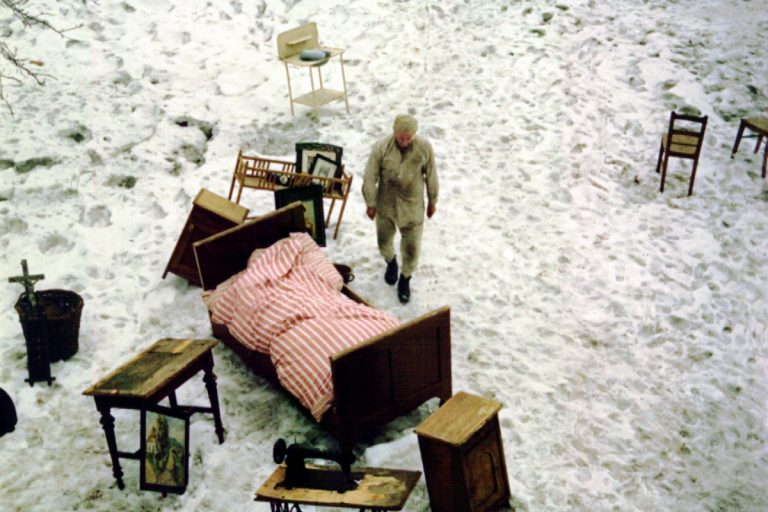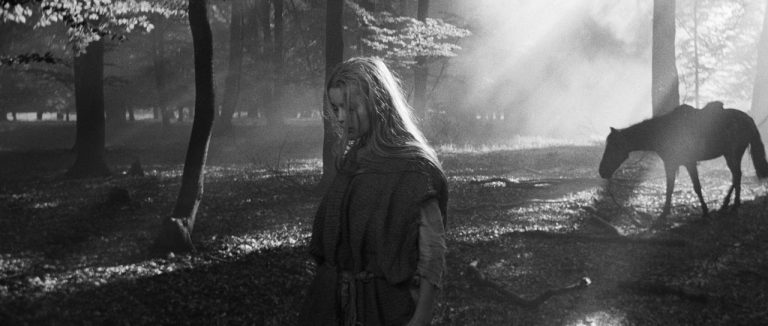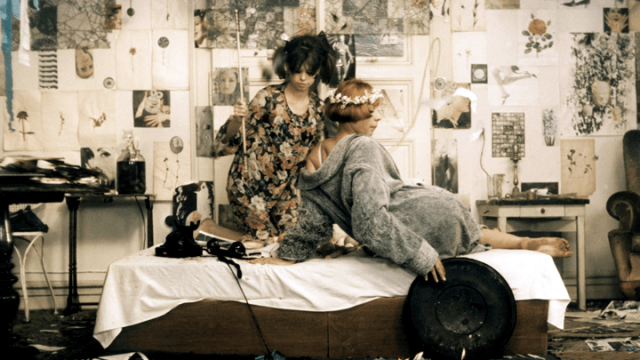When this month’s year–1966–was announced, I knew I wanted to do something on one of the films released by Czechoslovakia that year. But which one? The crown jewel is, of course, the experimental fantasy Daisies. Or maybe the Oscar-winning cringe-comedy/war-drama Closely Watched Trains? But what about the surreal allegorical forest of A Report on the Party and the Guests? Or why choose at all, when you have the manifesto-anthology Pearls from the Deep, which gives you five different directors to work with?
And if we’re going that route, why not just discuss the whole Czechoslovak New Wave in one fell swoop? It was a relatively short-lived phenomenon, stretching only a couple of years during socialist Czechoslovakia’s liberalization in the 1960s and ending with the Warsaw Pact invasion in 1968. There are no deep wells of polemical literature that have to be wrestled with (no Cahiers), nor any firm aesthetic-ideological divides between groups of directors (no “banks”). But taken as a whole, it represents one of the most concentrated flurries of cinematic energy the medium has ever seen. In only a few years, Czechoslovakia evolved from a regional cinema (no offense meant: I like a lot of the country’s earlier movies!) to become one of the world’s foremost centers of cutting-edge cinema. How did this happen, and why?

Some Very Short and Obviously Oversimplified Context
First, it didn’t happen in isolation: the Czechoslovak 1960s represented a sustained burst of creative energy that the country hadn’t seen since the interwar period. Though the communists had been in control since the late 40s, and frequently exercised a censorship and repression culture as cruel as any in the bloc, the country’s distance from Moscow–and close proximity to the West–had made it possible for productive tensions to bubble over the border (sometimes literally: the era’s great songwriter, Karel Kryl, fled to Germany in 1969 and broadcast back to his home country via Radio Free Europe).
The “Thaw” that marked the years of Soviet liberalism during Khrushchev’s early administration arrived later but lasted longer in Czechoslovakia, which remained somewhat recalcitrant as the Russian political system “re-froze” in the 60s. Czechoslovak artists were politically bolder, or at least able to be bolder, than many of their neighbors to the east. Literature in particular was in bloom: a young playwright named Václav Havel (whatever happened to that guy, eh?) was packing houses with satires of totalitarianism like The Garden Party (1963) and The Memorandum (1965). Upstart novelist Milan Kundera published his first novel, The Joke (1967) as a middle finger to the communist culture of paranoia and incrimination. Surrealist Bohumil Hrabal was just getting started with his playful distortions of reality. A whole generation of artists passed through the salon at Café Slavia, where poet Jiří Kolář presided. Allen Ginsberg went to Prague and raised hell. Nor was creativity limited to the “classical” arts: the nation’s long love affair with rock’n’roll was just getting into full swing, and especially what would become a fateful entwining with the underground scene, beginning with The Primitives Group.
Within this heady mix, a group of film students at Prague’s Film and Television School at the Academy of the Performing Arts (FAMU) lived, studied, worked, and experimented together, and it’s largely this group that we call the Czechoslovak New Wave (sometimes just the Czech New Wave, since it was based in and largely around Czech, but there were Slovak members, too.) They filmed at Barrandov studios, founded by Miloš Havel, the playwright’s uncle. In the space of only a few years, this cohort of directors took Czechoslovakian film industry from a largely unappreciated national cinema to the big leagues; to put this in an American context, they scored a Best Foreign Film nomination from the Academy in 1965 and every year thereafter until the invasion (and winning two), the kind of record usually associated with powerhouses like France, Italy, etc. And for all the movement’s brevity and close-knit quality, the range of material they produced makes it difficult to pin down anything like a conceptual through-line: we have intimate family dramas and mass-scale medieval epics, kitchen-sink realism and allegorical fantasy, films that avoid politics and others that dive right in, etc., etc. etc.
Alas, it couldn’t last forever: the invasion and subsequent crackdown on liberal elements resulting in many of these works being banned and many of these artists unable to continue creating, except in limited contexts. If Brezhnev hadn’t intervened, what might the country have produced with another decade of unfettered expression?

The Highlights
Let’s start with 1966 since that is, after all, the Year of the Month.
Daisies is widely considered the high point of the wave, and for good reason: there’s never been anything quite like Věra Chytilová’s wild fantasy, a quasi-allegorical romp that sends two young women, both named Marie, on a whirlwind-like path of destruction through bedrooms, night clubs, fields, and–most infamously–banquets. (BAM described the film as an “anarcho-feminist blitzkrieg,” which sounds about right). Don’t go in expecting a traditional narrative: Chytilová sets her women loose to destroy whatever crosses their paths, including, in one brilliant sequence, the film frame itself. And it ends with a legendary fuck-you of an epigraph.
But Daisies is a challenging film in the sense that it requires a different kind of engagement, so it didn’t make quite the splash that another ’66 film did at the time, Jiří Menzel’s Closely Watched Trains. That’s not to knock Menzel, who made a classic work of deeply awkward comedy out of Hrabal’s novel about a group of young Czech train station workers during the Nazi occupation. It’s a slapstick sex comedy with a very, very dark edge, but Menzel maintains Hrabal’s complex tone of irony mixed with sweetness, a genuine affection for a bunch of knuckleheads who get roped into a war they want nothing to do with. (Clip below is briefly NSFW)
The politics is peripheral here (or by making it peripheral, it makes a political statement of a different sort). At the opposite end, you have stuff like Jan Němec’s A Report on the Party and the Guests, which doesn’t bother with anything but the flimsiest of subtexts as it strikes a direct blow at the ruling regime. Set entirely in a forest of deeply unclear parameters, inside which a group of guests keep getting “detained” on their way to a strange, elaborate feast, it was one of the few films on this list banned before the invasion: even the liberal order had its limits.
1966 was in many ways the most productive year of the New Wave, but it’s worth peeking around the corner at a few films made just before and after. The country’s first-ever Academy Award went to the Slovak-language film The Shop on Main Street, an anti-Nazi drama that was so well-regarded that its lead actress (Polish stage legend Ida Kamińska) even scored an acting nomination from the Americans that year. Like a lot of postwar films from Central Europe (and unlike, sadly, Hollywood), the film is more interested in trying to understand how “ordinary” people allowed the Holocaust to happen: here, the “ordinary” Slovak carpenter Tóno, assigned as the “Aryan” manager of an elderly Jewish woman’s store, just wants to keep his head down as his community becomes increasingly bigoted. But what are the contours of his own complicity?
At the other end of the spectrum, or at least seeming to beam in from another universe, is František Vláčil’s dense medieval epic Marketa Lazarová. The film is notoriously difficult for its refusal to hold the viewer’s hand, a trait it shares with the twisty, deliberately archaic prose of Vladislav Vančura’s novel. It is, frame-for-frame, one of the most striking, beautiful works ever filmed: Beda Batka’s black and white photography is nearly unmatched, moving fluidly across stark landscapes that soon become stained with blood. (It’s no surprise at all that Ben Wheatley studied the film before making his A Field in England).
Finally, there’s the most decorated of all the New Wave’s directors, the incomparable Miloš Forman. At least two of his films from this period are must-sees, beginning with his exquisite cringe-inducing socio-sexual dramedy Loves of a Blonde (another Oscar nominee). The film follows Andula, a naive young factory worker who just wants to be loved, which makes her easy prey for a visiting musician guided by hormones alone. When Andula mistakenly believes his promises of love, she hitchhikes to the city to meet his parents, and… you can guess where this is going. Hana Brejchová is just plain heartbreaking here, even when the movie around her is laugh-out-loud funny, with scene-stealing work from Milada Ježková as the would-be loverboy’s mother.
But if I had to pick one film other than Daisies to recommend to people new to Czechoslovak cinema, it’d have to be Forman’s next film, the one that created such a scandal that it basically ended his career in his homeland. While on location for Blonde, Forman and his collaborators decided to make a comedy about a provincial volunteer fire department whose annual charity ball goes disastrously, hilariously wrong. The Fireman’s Ball is so deliciously Czech in its sensibilities: it takes giddy delight in incompetence and stupidity, a nation of slapstick Švejks who can barely tie their shoes without bringing the whole building down around them. It replaces Blonde‘s tenderness with acid satire, where every single character is conniving, lecherous, doddering, or some combination of them all, so it’s not exactly a surprise that the powers-that-be interpreted Forman’s film as a political attack on his socialism-building compatriots. Anyway, it’s the reason we ended up getting him, and things turned out pretty well for him here, didn’t they?
These are just the best-known films from the era, and we’ve only barely scratched the surface of what an exciting, intoxicating decade Czechoslovakia experienced before the tanks began rolling in. If there are others you’ve seen and want to talk about, by all means, drop em in the comments and let’s chat!


